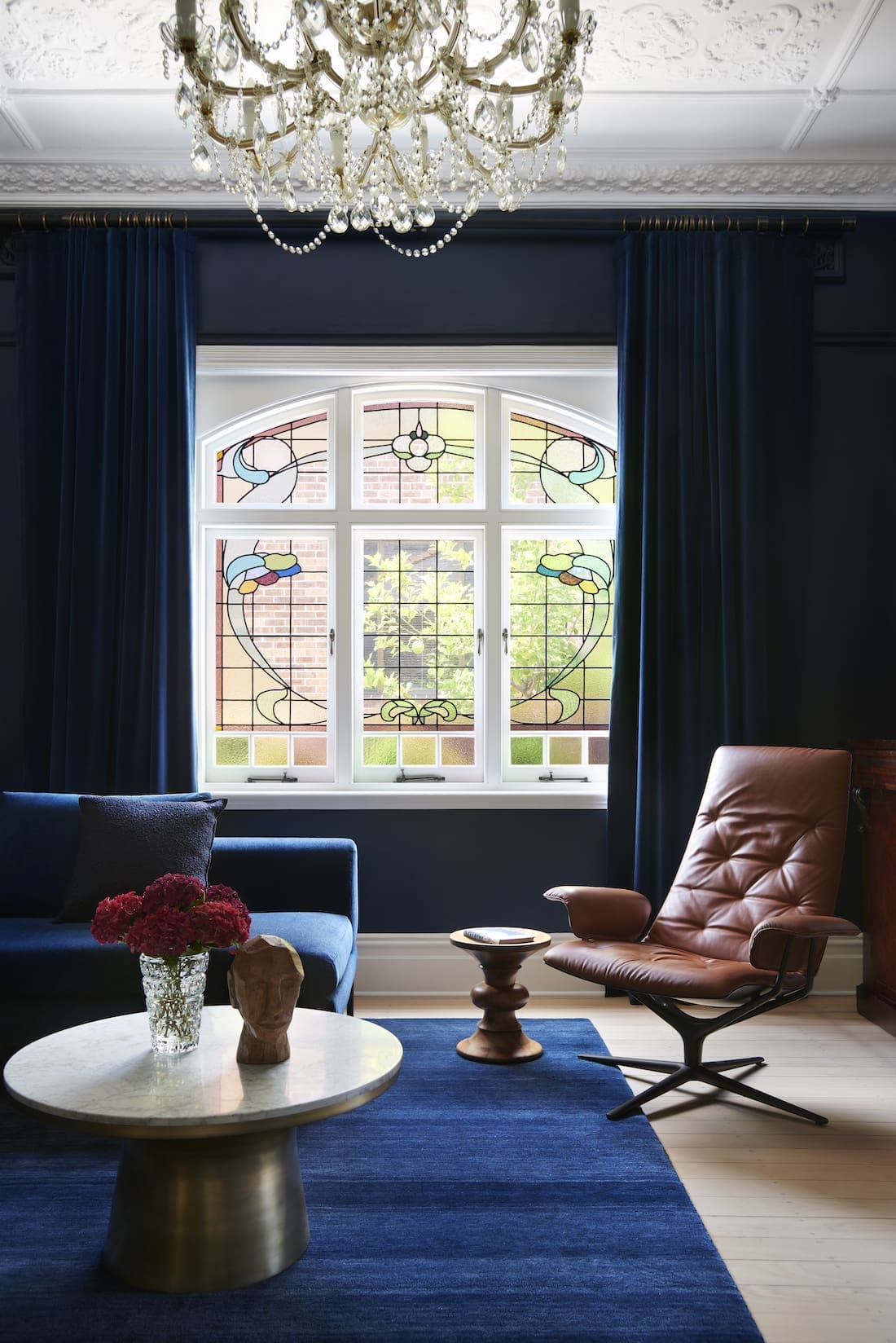Trend alert!! Move over light and airy living rooms, the latest trend is all about deep and moody living spaces. We love the impact of darker colours in interiors — they create drama and can elevate any space from drab to fab! Dark colour schemes are making a bold comeback on the interior design scene, and today we’re delving into the top tips and tricks to pull off a deep and moody living space!
Keep scrolling for all our interior styling tips and you’ll see dark and moody doesn’t have to equate to masculine or heavy. While deep hues will transform a lounge room, there are simple ways to keep it in the realm of cosy and intimate, or even dramatic and sophisticated. So get ready to embrace darker colours while using our tips and strategies to achieve a balanced and inviting environment.
Related article: Arcadian project: The small living room upgrade that packs a punch
Related article: Inspiration gallery: VJ panel living room walls

Evoking different moods with dark colours
Every colour of the spectrum evokes different emotions, and each colour can be in light or dark hues. So before selecting the traditional deep grey to create a dark and moody living room, we suggest thinking about how you want to feel in the space. Refer back to colour theory to identify the best colour to evoke those emotions, and simply select it in a darker hue. For example, if you want to feel creative, look for a deep burnt orange. Or if you want to feel balanced and rejuvenated, there’s no better option than a deep forest green.
In a lounge room, deep blues, rich charcoals, and velvety blacks are most popular to create a cosy and intimate setting. Blue is the most calming colour in the spectrum so using a dark navy wall colour in your living room is perfect for relaxation and unwinding. Charcoal and black on the other hand are dramatic colours that ooze sophistication and class. If you want to select a colour less commonly used, burgundy can also elevate the space while creating a sense of elegance and refinement.
Essentially, you can find dark colours capable of evoking a variety of atmospheres in interior design. Our top tip is to consider the mood you want to evoke and working backwards to develop your colour palette. Bonus tip, select a shade with warm undertones to make the space feel warm and secure.
Starting small: Accent walls and accessories
If you’re not ready to fully commit to a dark and moody living room, you can dip your toe in with smaller splashes of colour in the way of accent walls and accessories. Although we’re big fans of all walls and the ceiling painted in a dark hue, we also love the impact of an accent wall or strategically placed decor to set a darker colour scheme. This approach allows you to introduce dark colours without overwhelming the space or yourself. For example, a dark sofa or a set of midnight blue cushions can add depth to the room without committing to a full transformation.

Balancing dark and light tones
Great interior design is all about contrast — matte and gloss, high and low, angular and curved, and dark and light. To pull off a dark livingroom that still feels inviting and homely, it’s essential to balance dark colours with lighter tones. Light-coloured furniture, rugs, and artwork can create contrast and lift the space.
For example, take a look at the image below where the timber flooring and lighter tan, timber and brass furniture lighten the otherwise monochromatic midnight blue living room.
Some easy ways you can balance dark and light tones in a living room are:
- hanging lighter artwork on dark painted walls
- contrasting your rug from main flooring
- selecting a mix of light and dark furniture.
Ultimately, it’s all about striking a harmonious balance to create visual interest while keeping the space inviting. If you really want to lean into a dark colour palette, we still suggest using 20%-30% lighter elements.
Maximising natural light
Natural light is a crucial element when working with dark colour schemes. Without it, a space can quickly feel claustrophobic!
If you have windows, make the most of them. Keep windows unobstructed (or at a minimum, pull furniture at least 30cm from the wall) and you can maximise natural light by using sheer curtains to allow sunlight to filter through.
Another tip to enhance natural light is to position mirrors strategically. Place mirrors opposite windows or light sources to maximise their reflective properties. A statement mirror can also serve as a focal point, adding both function and style to the room.

Layered lighting strategies
One of the most overlooked aspects of interior design is lighting! And in a dark living room, a successful lighting plan is even more important to prevent a room from feeling cavernous. Layered lighting involves using multiple light sources to create a well-lit, inviting space. Overhead fixtures like downlights provide general illumination, while floor lamps and table lamps offer focused lighting for reading or relaxation. Accent lighting, such as wall lights or LED strips, can highlight artwork or architectural features, and are considered the jewellery of the space.
Incorporating a range of materials and textures
Remember what we said earlier that great interior design is all about contrast? Well, that’s why using a varied materials palette is another top interior styling trick.
Textures add depth and visual interest. When styling a lounge room with dark colours, materials like velvet, leather, and wood complement dark hues and contribute to a rich, layered look. For instance, a velvet sofa in a deep green shade can be a luxe statement piece, while a wooden coffee table adds warmth and contrast. Mixing different materials and textures prevents the space from appearing flat and enhances its tactile appeal.

Tailoring the scheme to your lounge room’s function
Are you creating a dark and moody sitting room, formal lounge, media room or family living room? As well as considering the best colours to achieve the mood you want, it’s also important to consider the best materials to suit your rooms function.
A luxe marble and brass coffee table may not be the best option for a family living room if you have young children. Similarly, a glass coffee table can reflect screens so if the primary function of your living space is to watch movies, a timber or stone coffee table would be better. Consider the purpose of your space before selecting furniture and decor, such as local stores with modern furniture in Melbourne.
Matte and low-sheen finishes
Matte or low-sheen finishes are ideal for dark-coloured walls and furniture. These finishes minimise glare and contribute to a softer, more sophisticated look. Matte surfaces absorb light, reducing reflections and enhancing the room’s cosy ambience. For furniture, low-sheen finishes can maintain the elegance of dark colours without overwhelming the space with too much shine.
Adding contrast with bold accents
To add that final layer of style, we love injecting a few bold accents. These could be pops of colour, patterns or metallic finishes. They’re yet another way to play with contrast, and will lead the eye across the room. In a dark colour scheme, think vibrant cushions, patterned rugs, or metallic accessories like gold or brass lamps. Best of all, you can easily swap out these pieces to refresh the space as the season or your mood changes.
We hope these tips on how to embrace dark colour schemes in your lounge room inspires you to take the plunge or at least dip your toe in! By starting with a room’s function and how you want to feel, you can set a dark colour scheme that won’t just look good but will enhance your home. Carefully selecting furniture, such as entertainment units in Melbourne or modern furniture pieces, is also key to creating a lounge room that’s practical and sophisticated.
More living room inspo








